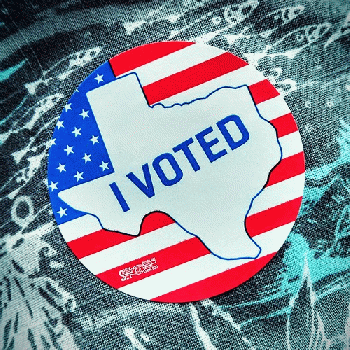From LA Progressive
More than 30 statewide elections will be held in the 91 days from May 19 to August 18, previewing how unfamiliar or difficult absentee voting may be across America this fall.
The next big test is June 2, when eight states and the District of Columbia hold their presidential primaries. Despite President Trump's claims that absentee voting cannot be trusted, red-run states (Indiana, Iowa, South Dakota) holding primaries that day have more experience with voting by mail and voters dropping off ballots at polling places than blue states and territories (Maryland, New Mexico, Pennsylvania, Rhode Island and D.C.). Only one state in this group, purple Montana, has held an election where most people voted absentee.
States are turning to absentee voting in response to the pandemic. But as the next wave of statewide contests nears, experts are beginning to worry about the capacity of many states to handle surges of mail-based voting -- now and in the fall. April's primaries in Wisconsin and Ohio were mostly mail-based elections that were beset with problems due to partisan factors and rapidly changing plans. Meanwhile, many election officials preparing for June 2 primaries are scrambling.
"Administrators have struggled to accommodate both the requests for and issuance of absentee ballots in a timely manner during low turnout primaries," Christopher Thomas, Michigan's former election director, and Matthew Weil, director of the Elections Project at the Bipartisan Policy Center (BPC), wrote in one of the few recent reports to assess voting in the pandemic. "During a high turnout general election, these [requests] are likely to overwhelm jurisdictions, causing huge delays in sending and subsequently counting absentee ballots."
In 2018, 52 million people, or 43.2 percent of voters nationally, cast ballots outside of Election Day in-person options, the U.S. Election Assistance Commission said. In 2016's presidential election, the figure was 57.2 million, the EAC said.
"Regardless of what policy changes are made, we predict that vote-by-mail ballots will represent more than half of all ballots cast in [the fall of] 2020," the BPC authors said, "which would be at least a 190 percent increase over 2016."
Precedents for the Fall?In the next three months, starting with Idaho on May 19 and continuing to Florida on August 18, more than 30 states will be holding presidential primaries or other statewide elections. While many states have updated some aspects of their absentee voting rules, what is becoming clear is that most of these states are not likely to offer voting options that meet the best practices touted by elections experts.
How easy or hard mail-based voting will be varies by state. A few states automatically send voters ballots. Most states require voters to apply for an absentee ballot. That step has variables, such as providing IDs, who pays for postage and deadlines. On the receiving end, officials have to vet applicants and then send ballots. Ballots have to be returned on time with correctly filled-out envelopes or dropped off at polling places. Just like voters are checked into precincts, these envelopes have to be vetted before ballots are counted. These steps are laborious, even with technology that automates some of the processes.
The dividing line between less-prepared and better-prepared states does not always follow the map of red and blue states. While there is a split among some GOP-run states that are making absentee voting easier (ignoring President Trump's rants that mail-based voting cannot be trusted) and states where partisan legislators are forcing state election officials to impose procedures that have confounded voters, the real dividing line is battleground and non-battleground states.
The most recent example of that contrast can be seen in Ohio and Nebraska, which held their primaries on April 28 and May 12, respectively. The rule-heavy process in Ohio resulted in 20 percent voter turnout, a historic low. Two weeks later, nearly 14 percent of all ballots had yet to be officially accounted for (see "Ballots Cast" tab). Nebraska, in contrast, loosened its rules and sent absentee ballot applications to all registered voters. It set a turnout record that was 14 percent higher than its prior record set during 1972's primary. (In 2018, 24 percent of Nebraskans had voted absentee, underscoring its experience with mail-based elections.)
Looking to the 10 primaries on June 2, the assessments are not overly encouraging.
The National Vote at Home Institute (NVAHI), the leading national organization promoting mail-based voting, on May 14 issued a report assessing every state and the District of Columbia's ability to meet best practices. On a one-to-five scale based on 30 variables in running mail-based elections, six of the nine places holding June 2 primaries received a low grade of two (Indiana, Iowa, Maryland, Pennsylvania, South Dakota and Washington, D.C.). Two states received a grade of three (New Mexico, Rhode Island) and one a grade of four (Montana).
The NVAHI report is a policy document. It strives for what it considers to be the ideal. As its experts said on a May 14 conference call, a successful vote-at-home election is glitch-free and boring. They cited Alaska's trouble-free Democratic Party primary and Wisconsin's problematic primary (for both parties), both held the same week in April, as counterpoints.
The contrast makes a broad point, but the two primaries were different in scale. Alaska's party-run primary had 19,600 voters -- all were sent mail-based ballots, while Wisconsin's government-run primary had 1.55 million voters, who endured court fights, had to request absentee ballots or had to find an open polling place to vote.
(Note: You can view every article as one long page if you sign up as an Advocate Member, or higher).






